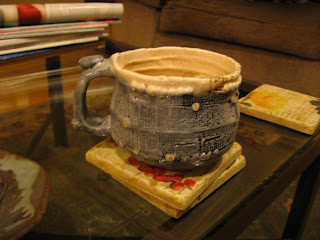Here are some photos of the finished work from this quarter. I had a few more pieces than I show here, but hope these pieces are characteristic of what I am doing now.
I want to start discussing porcelain pieces using Kleiber clay from Tacoma Clay Arts. This is a small, flat bowl made using slab construction with a celedon stone ware glaze. I like this one because it has a "Wabi Sabi" lip and some funky features.
This is a "square bowl" made from a slab. The glaze is a combination of Satin Pearl and Woodland Creek Celedon. The lip is cut. This would be a good coin dish or such. Perhaps it would be useful when panhandling.
Another very poor photograph, guess I need a "White box" or such to take better photos. Sometimes I borrow "flat black" boards from Jo Miles for close ups, but I didn't have time to set up some photo box for these photos. Enuff about photographs. These are a matching cup/bowl set with shino under glaze and Celedon over glaze. I like the splashed celedon in the bottom of these pieces. These bowls are a bit flat but are ideal for nuts or munchies?
Same poor lighting and same glaze theme. I like to make cups and these two are a set. For some reason Shino fires different inside a cup than outside. Inside it is a mellow orange that inspires drinking and the blue celedon give a compelling finish. I try to drink coffee out of each of these cups to see how they actually work at the table. No two cups turn out the same.
Let's move along to the earthenware "JG" clay that I worked with the last part of the quarter. I fired two of these as raku cups (see my "raku" post later in the week) or as cone 06 glaze tests (see that blog later in the month). This first one shows it at the stain stage. I applied Cobalt Carbonate and Red Iron Oxide and it's looking OK here.
This is an interesting earthenware cup (below). I applied Cobalt Carb in a very concentrated stain to the side and bottom, then covered the cup with an earthenware clear glaze. At this solution the cobalt makes it look like a black raku piece. I've been drinking tea out of this cup for a week and it does not do well with a microwave as the absorbed organic material bakes out of the cracks and the handle is too hot to use for several minutes when removed from the micro. The cup is also "clunky" on the table but nonetheless, I like it as a personal cup. It has no market value as the normal customer would not be entertained by it's strange characteristics when exiting the microwave oven.
The next set are earthenware glaze tests on two JG pieces, a cup and bowl. I used black Iron oxide stain but at cone 06 the stain is a purple/pink, shown by this cup. I put a commercial gray cone 06 satin glaze on the lip of the bowl and like it against the pink (shades of Elvis Presley?). I'd say these pieces are not suitable for use but who knows. My objective is to now use these forms for further earthenware "over" glazing tests. Any Ideas??
Here, below we see a biscuet JG cup. I have about 10 of these bare biscuit pieces that I want to use for low fire glaze tests. I want to try Burnt umber stains and various over glazes. I am going to perform most of these glaze tests during Winter quarter so I can process them one (or two) at a time and add to each experiment. My objective is to not try and replicate stone ware, but also capture some of the unpredictable nature and surprise characteristic of that glaze temperature.
I also did three earthenware jars this quarter. One was a reverb drum that I constructed to see how I could get good "sound bounce" from a clay drum. I didn't bother with a picture of it,,, perhaps in a future drum post? These two pieces are much alike and much different. The first one is more organic. I hope to show it at the Bellevue show in March.
After applying waxes to the surface I am about 80% satisfied with the surface. I will continue to work with surface treatments of burnished and scraped earthenware jar surfaces. This jar is about 16" in diameter and will make a good garden feature or seed storage jar. It won't be freeze resistant unless it remains dry, much like the jars made in the southwest US 1300 years ago. Here is one more new jar.
I like this shape. The brown 06 interior glaze was somewhat successful. I like it but want to continue to work at getting an interior glaze to be more compelling and to fit in with the finished piece. This jar is also large. I think it might be good indoors for storing fiber such as knitting supplies or yarn.
Well, that's it for fall/11 quarter. I plan to post a few more blurbs before 2012 on smoke fire, raku, drop spindles, and a few other subjects. Stay tuned and if you want some reading material over the christmas break read back in my blog to earlier posts. I want to say that my studio is coming along fine and I hope to start doing actual work out of it as soon as I get my sound system running, a few cafeteria trays to store clay slabs, and my 220V electrical circuit converted to the plug on my kiln. I can't imagine making ceramics without listening to Katy Perry so I want to get some really BIG speakers!!!










No comments:
Post a Comment